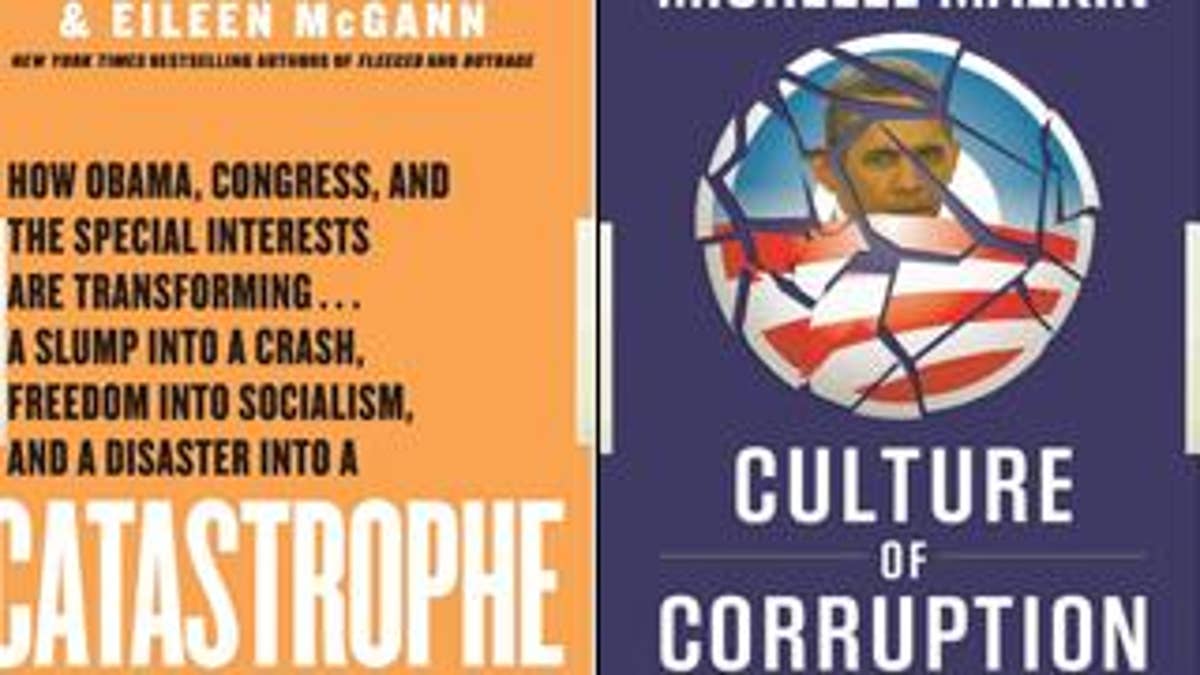
Book sales ... blog visits ... tea parties ... town halls ... a national poll ... There is increasing evidence of a shift in the political winds: the nation is swinging right after President Obama's victory last November.
A recent Gallup poll found that people who identify themselves as conservatives now outnumber liberals in every state. And that tilt is reflected in book sales, with three political books by conservative authors listed in the Top 10 New York Times nonfiction bestsellers: "Culture of Corruption" by Michelle Malkin, "Liberty and Tyranny" by Mark R. Levin, and "Catastrophe" by Dick Morris and Eileen McGann.
There are no political books written by liberals on the list.
Some media analysts say it's a sign that the mainstream news media are biased and out of touch, which is driving conservatives to find their information in other forms of media.
But others, including the books' publishers, say it's just a sign of the times -- a reflection of the change of power in Washington. Sales are up, they say, because Democrats control Congress and the White House, and conservatives are frustrated.
"We, frankly, expected to see a rebound in conservative books after Barack Obama's election," said Marjory G. Ross, president and publisher at conservative Regnery Publishing.
"There is a phenomenon when one party is out of power that people are searching for leaders ... from their side. And if they don't see those people in Washington, they often look for media and celebrities outside of Washington to support their cause."
She said Regnery has seen an increase in sales, especially in the last couple of months.
"We right now have more than 300,000 books in print for Michelle Malkin's book ... more books in print for a single title than we've had for two years."
Penguin books' conservative imprint, Sentinel, agreed.
"No question, conservative voices are back on the upswing again," Sentinel spokesman Adrian Zackheim said, adding that it recalled "the heady days of the Clinton White House, when conservative books frequently dominated the bestseller lists."
Liberal pundits also are noting the trend. Michael Huttner and Jason Salzman, authors of "50 Ways You Can Help Obama Change America," wrote at HuffingtonPost.com that they hope their book "contributes to changing the dialogue in this country, at a time when ... books by right-wingers Michelle Malkin, Glenn Beck and Bill O'Reilly [are] topping this week's national bestsellers list."
Data on New York Times bestsellers confirms the increase in conservative titles since November and shows that liberal authors did well during the Bush administration.
But some media experts say that what's happening now reflects a more fundamental shift toward conservative writing -- both in books and on the Internet -- caused by an elite media that ignores conservative voices.
"In the old analog era, New York's elite media could get away with ignoring much of the rest of the country, perhaps even having a certain disdain for parochial Americans who didn't see things their way," DePaul University journalism professor Bruce Evensen said.
"Now, in the digital age, these 'savages' are having their revenge. Conservatives dominate much of the blogosphere in news and information, because for so many years liberals have dominated [old media]."
Liberal analysts agree that conservative book sales are up, but they say it's due solely to angry conservatives, not perceived media bias.
"The right has always complained about a phantom liberal bias in the media, so that doesn't strike me as a likely cause," said Peter Hart, activism director at Fairness and Accuracy in Reporting.
"I think the biggest factor is talk radio. Conservative hosts can use their national shows to push their books, or books by like-minded authors, to an audience that is feeling marginalized and angry."
The shift to the right is also apparent on the Internet. Arizona State University professors Kevin Dooley and Steve Corman looked at the 20 most popular conservative and liberal blogs on the Web, counted the sites they linked to -- and then followed the sites those linked to, and so on. They ended up with a list of 814 conservative blogs, compared to 436 liberal ones. The conservative blogs also had more total posts.
"There was really no subjective intervention on our part, so I have faith that our population is representative of the number of blogs," Dooley said.
Social media consultant Simon Owens said he found that conservative blogs had lost fewer readers since November. While the conservative blogs are now getting 37 percent fewer page views than during the election season, the liberal blogs have lost almost twice as many: 64 percent of their Web site hits.
In some cases, Internet activism feeds into real-world demonstrations. Many of the tea party protests that drew conservatives out in large numbers in the spring -- organizers estimated that there were at least 790,000 protesters around the country on tax day -- were also organized online.
Town hall meetings about health care have also generally been packed. Local media outlets reported that hundreds had to be turned away at town halls hosted by Sens. Arlen Specter (D-Pa.) and Ben Cardin (D-Md.) and Rep. Gene Taylor (D-Miss.).
"Conservatives are much more prominent now than when we started doing [media analysis in 1987]," said Daniel Amundson, research director at George Mason University's Center for Media & Public Affairs. "Increasingly now you see people from conservative groups or conservative politicians showing up and supplying commentary to the press. I think they have become, I wouldn't say even players, but on the field in a pretty significant way."
He cited the town hall protests as an example of increased visibility.
"I'm hard-pressed to think of too many other situations where you've had coverage of town hall meetings across the country."




